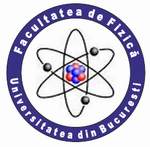| |
 |
UNIVERSITY OF BUCHAREST
FACULTY OF PHYSICS Guest
2025-10-05 22:30 |
 |
|
|
|
Conference: Bucharest University Faculty of Physics 2025 Meeting
Section: Atomic and Molecular Physics. Astrophysics. Applications. Optics, Spectroscopy, Plasma and Lasers
Title:
Phase transition dynamics in a strongly coupled plasma under electron beam exposure
Authors:
Beatrice PARASCHIV (1,2), Dorina TICOȘ (1), Nicoleta UDREA (1), Maria Luiza MITU (1), Adrian SCURTU (1), Mihai OANE (1), Catalin M. TICOȘ (1,3)
Affiliation:
1) National Institute for Laser, Plasma and Radiation Physics, 077125 Măgurele, Romania
2) Faculty of Physics, University of Bucharest, 077125 Măgurele, Romania
3) Extreme Light Infrastructure-Nuclear Physics (ELI-NP), Horia Hulubei National Institute for R&D in Physics and Nuclear Engineering, 077125 Măgurele, Romania
E-mail
beatrice.paraschiv@inflpr.ro
Keywords:
electron beam, phase transition, plasma crystal, dusty plasma
Abstract:
Plasma crystals, formed by charged microparticles in complex plasmas, exhibit ordered structures that can undergo phase transitions under external influences [1]. While temperature and pressure effects on crystallization are well-studied, the role of electron beam energy in driving structural dynamics remains underexplored. This study investigates the behavior of a 2D plasma crystal composed of 11.8 μm melamine-formaldehyde particles, suspended in an argon RF plasma, under electron beam exposure in the 9–14 keV energy range. Structural changes were analyzed using Voronoi diagrams and pair correlation functions g(r), while particle dynamics were tracked using Particle Tracking Velocimetry (PTV) to evaluate average velocity and kinetic energy over time. At low beam energies (9–10 keV), the system remains largely ordered, showing only minor increases in kinetic energy and limited structural disruption. As the beam energy increases, significant changes occur: starting from 11 keV, a sudden rise in kinetic energy is observed around t₀ = 0.54 s, coinciding with a rapid breakdown of crystalline order, as indicated by the flattening of g(r) peaks and broader velocity distributions. Additionally, a frequency analysis of kinetic energy fluctuations using Fast Fourier Transform (FFT) shows dominant frequencies below 5 Hz, associated with slow, collective particle oscillations [2]. With increasing beam energy, the amplitude and spread of these frequency components increase, indicating stronger excitation and more disordered motion. At 14 keV, although the peak amplitude slightly decreases, the spectrum becomes wider, suggesting chaotic particle dynamics and the loss of structural coherence. These results show that electron beams can effectively trigger and control structural transitions in plasma crystals, in a way comparable to shear-induced melting and externally driven phase changes observed in previous dusty plasma experiments [3]. The findings contribute to a better understanding of beam–plasma interactions and energy transfer processes in strongly coupled dusty plasmas.
References:
[1] H. Thomas, G. E. Morfill, V. Demmel, et al., “Plasma crystal: Coulomb crystallization in a dusty plasma,” Physical Review Letters, vol. 73, no. 5, pp. 652–655, 1994.
[2] Y. Feng, J. Goree, and B. Liu, “Evolution of shear-induced melting in a dusty plasma,” Physical Review Letters, vol. 107, no. 3, p. 035001, 2011.
[3] D. Ticoș, A. Scurtu, J. D. Williams, L. Scott, E. Thomas Jr., D. Sanford, and C. M. Ticoș, “Rotation of a strongly coupled dust cluster in plasma by the torque of an electron beam,” Physical Review E, vol. 103, no. 2, p. 023210, 2021.
Acknowledgement:
This research was funded by Ministry of Research, Innovation and Digitization under contract NUCLEU.LAPLAS VI, P.N. 19.15/16N2019.
|
|
|
|

